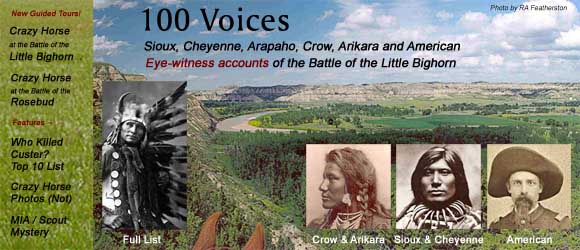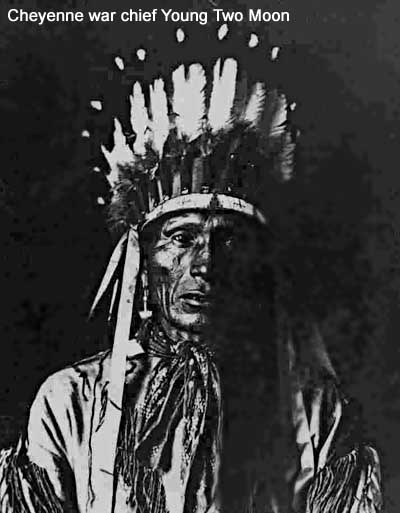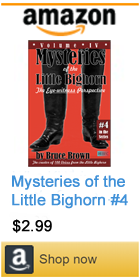|
||||||||||||
Bruce Brown's 100 Voices... Young Two Moon's Story of the Battle
While here seven Arapahoes came into camp. [Note: Waterman, who was one of the Arapaho party, said their number was actually five, not seven.] They captured them, took their arms and horses and part of their clothing and were going to kill them. Every one believed that these were scouts from some camp of soldiers. Two men took their part -- Black Wolf and Last Bull. They said the people should wait and not act hastily. They were taken into Two Moon's lodge, but it was closely surrounded. While there many Sioux came up with cocked guns which they pointed at them saying that they must be killed. Women who had had relatives killed came up crying and asked for the lives of the Arapahoes. Most said this is Two Moon's lodge. Wait till he comes, let him decide. They sent a young man out to look for Old Two Moon. He was found at last in one of the Sioux camps and came. Meantime, while they were searching for Two Moon they took Arapahoes out of lodge. Old Two Moon came to his lodge with five other chiefs and called to the Arapahoes to come in. The chiefs were going to decide what should be done with them. After they had talked awhile, Old Two Moon called out: "These Arapahoes are all right. They have come here to help us fight the soldiers. Do not harm them but give them back their things." Sioux chiefs called out the same things, and their horses, arms, and clothing were returned. After this some old people called out to take the Arapahoes and let them go to separate lodges and be fed. They divided them and took them away but were directed to bring them back to Two Moon's lodge. Then they moved camp down below mouth of Reno Creek and stayed there one night. The next day Custer came, not early in the morning. John Two Moon was three miles from where the fight took place and saw it all, but did not take part in it. His account should therefore give [a] good general idea of what took place. When he first saw the soldiers they were just coming down the steep hill east of battlefield. They were on a lope and Indians were then behind them but they paid no attention to them. This was Custer's command. He saw nothing of Reno's battle. It was out of his sight. After the soldiers turned upon the little ridge the gray horse company stopped where [the present] monument is. The others went on, stopping at intervals until there were four lines, the last opposite to the camp. After they saw soldiers there, [Young] Two Moon, who was nearer to the river on a hillside ran with others and caught their horses and rushed toward the fight. Several charges had been made but no fighting had been done. Indians were struggling up the gulch northeast of soldiers like ants rushing out of a hill. Yellow Nose made two dashes toward soldiers and returned and said to his people, "Let us charge. "The third company-the one toward the river-had moved back a little toward the second. The Indians were trying to drive the three companies on this ridge running about north and south over to the gray horse company. Yellow Nose made a third charge but the other Indians did not follow him. Meantime, the Indians were getting further to the north trying to surround soldiers. At the fourth charge, on Yellow Nose's orders, all Indians mounted and Yellow Nose made a charge and all Indians followed. They crowded the company furthest north and they started to run down the ridge. As they got down part way toward the gray horse company the latter began to fire and drove Indians off and the soldiers reached the gray horse company. Some [soldiers] were kiled, however, when they reached the gray horse [company]. The latter shot at Indains so fast that they drove Indians back out of sight over hill toward the [location of the later Crow] agency. The same Indians called out very loud, "All dismount,"and they did so. It was done quickly. When Indians dismounted they shot at soldiers who retreated for the top of the hill. Then all Indians mounted and charged. Then the gray horse company turned their horses loose, and some of the horses rushed through the Indians and toward the river. When Indians charged to top of hill they saw the other two companies way down near to the river. Then all the soldiers turned their horses loose. The gray horse company was destroyed on the hill near where they went out of sight. The Indians charged in among them. One of the companies retreated down toward a little gulch where they tried to fight under cover. Here the last of the soldiers were killed. He saw and [?] what the gray horse company did and those who took refuge in the little creek. Those in the creek were all killed before he got there. If these soldiers had all stood together the Indians could have done nothing with them. The yelling of the Indians seemed to frighten the cavalry horses and they were naying and plundering so that the men could not handle their guns. If the horses, after they had been turned loose, had come to a shallow place in the Little Horn River, they would have crossed it and no one knows when they would have stopped. [Instead,] they struck a deep hole in the river, could not get out on the other side and stayed there swimming around. The Indian village was a large one and besides there were many young men there. Sioux from as far as the Missouri River were there, all warriors. He guesses that each soldier had to fight about forty men. . . . [Months earlier] they were camped over near Black Hills when they sent runners to call warriors [from] Red Cloud, Spotted Tail, Standing Rock [agencies], etc. Each lodge had from four to six men in it. . . . There were more than 200 lodge of Cheyennes and six Sioux camps, each of which was much larger than the Cheyenne camp. There were some Yankton Sioux. This would perhaps make 1700 lodges. Five fighting men to a lodge = 8500 men. . . . He says that if Custer and Reno had charged through the village from both ends they would have defeated Indians. [Note: This is exactly what Custer tried to do at Medicine Tail Coulee, but White Cow Bull intervened. See Who Killed Custer - Top Ten List for more info.] During night some of the [Reno] soldiers got water somehow without being seen. During the night some [cavalry] horses got loose and ran down to creek where they had crossed to get water. The Indians got them. Next morning one soldier stripped to his underclothing ran down to river and they began to fire at him. He carried a quart cup in one hand and a canteen in the other. When he reached it he threw himself in water, filling his vessels and drinking at the same time. Half the time they could not see him because of the water thrown up by the bullets. Then he ran up the hill again and entered the breastworks unhurt though they had been firing at him all this time. Next day they [the Indians] stayed there until about 5 o'clock when they heard that soldiers were coming and some of Indians went down to meet them. Then Indians began to leave Reno and called out to move camp. They did so soon and when they had moved off a little way they could see Reno's soldiers going to river. Not far from his breastworks on a little flat Reno put up tents. Lakota and Cheyenne: Indian Views of the Great Sioux War, 1876-1877 by Jerome A. Greene, University of Oklahoma Press 1994, p 46 - 48
Young Two Moon, also known as John Two Moon, was a nephew of Old Two Moon. Here is Young Two Moon's account of the Battle of the Rosebud, where White Shield saved his life.
|
||||||||||||




 WHILE FIGHTING Crook on Rosebud the camp moved from head of Reno down a short distance perhaps four miles. After two nights here they moved to mouth of Reno Creek and above mouth of Reno. He thinks they were five or six days in that camp.
WHILE FIGHTING Crook on Rosebud the camp moved from head of Reno down a short distance perhaps four miles. After two nights here they moved to mouth of Reno Creek and above mouth of Reno. He thinks they were five or six days in that camp.







